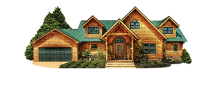Log homes aren’t just beautiful—they’re built to withstand extreme conditions, including fire. Here’s why solid log walls provide superior fire resistance and how smart design choices can further protect your home.
By Steve Lykins Architect/Engineer at Hochstetler Log Homes
My own design philosophy is that we design homes and other structures for the worst conditions that we expect they might encounter during their lifespan. In fact, these extreme conditions are the reason that we need shelter. Our shelters would look very different if every day was 72 degrees and sunny with just enough breeze to keep us cool. We must anticipate events such as floods, tornadoes, earthquakes, blizzards and fires. Of these events, fire is universal. Fire can happen anywhere anytime, whether it’s cold or warm outside, whether you’re on a mountain or on the coast. Here’s a brief look at why a log home is a top choice for endurance and integrity in a fire.
The Science Behind Log Homes & Fire Resistance
There are a number of technical publications out there that support the idea of a log home as a fire resistant shelter. For technical reading see “Fire Performance of Log Walls” prepared by the Log Homes Council Technical Committee, “2012 National Design Specification for Wood Construction” published by the AF&PA American Wood Council and “Structural Fire Design: Wood” published by the Forest Products Laboratory. This article takes a more practical approach while considering these technical aspects. As a practical experiment, next time you are enjoying a nice campfire or you’re warming your bones next to your fireplace or wood stove, toss a handful of sawdust into the fire. Observe how the sawdust combusts in a flash. Next, take a piece of a 2x4 and toss it in the fire. Observe how it burns much slower than the sawdust, but still burns almost completely within about 30 minutes. Finally, toss a large 10-inch diameter piece of a log into the fire. Observe how it takes hours and hours for this piece to burn completely. This is a practical (and cozy) way to understand how log homes perform in a fire. When a large piece of timber (i.e. log) is subjected to fire it begins to char. This layer of char on the outside of the log forms an insulating layer that protects the rest of the log from the effects of the fire. This char layer on a burning log works very much like some high-tech intumescent paints and coatings used to protect steel and other building materials from fire.
This experiment uses only a single log. Now imagine a wall of logs stacked on top of one another where each log helps protect its neighbor. This wall of stacked logs will perform even better in a fire than a single log or timber. Some credible log wall fire resistance tests have been performed showing that the wall might stay structurally intact for 2 ½ hours or more, allowing plenty of time for occupants to escape! It is no surprise then that a stacked log wall will perform better in a fire than a post and beam or especially a stick framed wall, in which the wood is exposed to the fire on all sides. In post and beam and conventional stick framed construction the walls generally have cavities, which feed the fire in the wall with oxygen allowing it to grow hotter, faster. This type of wall construction may burn to the point of collapse in as little as 20 minutes. It is for these reasons that solid log walls (at least 6” thick) are afforded a 1-hour fire resistance rating by current building codes, with even greater fire resistance ratings for thicker log walls. Independent, third party testing agency Underwriters Laboratories, Inc. has listed a log wall assembly as a 1-hour fire resistance rated wall construction assembly for use in not only homes, but structures of all types.
Log walls do not always need to have a fire resistance rating. Residential building codes only require an exterior wall of a home to be fire resistance rated when there is a neighboring structure (i.e., shed, garage, barn, etc.) within 30 feet. However, where a Garage is attached to a home, the separating wall between them must have an equivalent 1-hour fire resistance rating. These requirements are meant to contain a fire after it has already started. It is wise to also take measures to try to prevent the fire from starting in the first place.
Fire Prevention: Design & Lifestyle Choices
Fire prevention is first priority. On the interior of the home fires may be prevented by design (i.e., maintaining clearances around fireplaces, stoves, etc.) and by lifestyle. Simple choices such as not burning candles, not smoking and carefully checking cooking appliances after use can go a long way to prevent fires from starting. On the exterior of the home, fires may also be prevented by design (keep distance to neighboring structures) and also by choosing to clear an area about 30-feet from the structure of vegetation and combustible materials, keeping trees pruned 6-feet from the ground, regularly removing limbs and leaves, cleaning gutters, storing firewood at least 20-feet from the structure and using a spark arrestor for wood burning appliances. Consider that a metal roof is afforded a better fire classification (usually Class B) than an asphalt shingle roof (Class C) because the metal ignites at a much higher temperature and because a burning shingle may break off and blow to the neighbor’s house to start another fire.
Fire Detection & Suppression: Protecting Lives & Property
Fire detection is the second priority. A simple installation of a smoke detector (or preferably a series of smoke detectors) is commonly known as the single most important factor in surviving a fire in a home. Locate smoke detectors immediately inside and outside each bedroom or group of bedrooms and be sure there is at least one smoke detector on each level or story in the home. Many fire suppression systems (“sprinkler systems”) are initiated by detection of smoke or heat from a fire, or both. A fire suppression system is an important consideration. While they are costly (ranging from about 1%-7% of the cost of the home) they save lives. How much is a life worth? Especially when it comes to your family? Keep in mind that fire suppression systems do not have to be a traditional sprinkler system that sprays water on the fire. Some systems use foam and some use an inert gas to smother the fire and starve it of oxygen. Some building codes are beginning to require fire suppression systems in new residential construction, but there is much resistance.
Fire containment, prevention and detection all add cost to a home, but in the case of a fire in your home they prove their worth! In fact, some features (like fire suppression) are given a credit by homeowners’ insurance providers. Some homeowners’ insurance policies for log homes have a higher premium than that of a comparable conventionally built home, but it’s not for the reasons you might expect. As we now know a log home will contain and withstand fire much better than a comparable conventionally built home, but the log homes are typically built in rural areas (further away from fire stations and fire hydrants), are sometimes second homes or vacation homes where the Owner does not live year-round and are generally more costly to replace because of the amount of labor involved in their construction. We must consider that a conventional home with the same criteria will likely have a higher insurance premium, too. So it’s not necessarily the fact that the home is constructed of logs that makes the premium higher, it’s more a factor of the location and use of the structure.
A dear family member of mine once said “I think log homes are beautiful, but I wouldn’t want to live in a pile of kindling”. My response was “A log home is more like an insulated fire safe than a pile of kindling, but that stick built house that you live in currently is like a pile of kindling wrapped in highly flammable plastic”. I have to give her credit though, because a log home certainly is beautiful!









